
95% of researchers rate our articles as excellent or good
Learn more about the work of our research integrity team to safeguard the quality of each article we publish.
Find out more
ORIGINAL RESEARCH article
Front. Artif. Intell. , 03 January 2022
Sec. Big Data and AI in High Energy Physics
Volume 4 - 2021 | https://doi.org/10.3389/frai.2021.718950
This article is part of the Research Topic Operational Intelligence View all 4 articles
 Lasitha Vidyaratne1*
Lasitha Vidyaratne1* Adam Carpenter1
Adam Carpenter1 Tom Powers1
Tom Powers1 Chris Tennant1
Chris Tennant1 Khan M. Iftekharuddin2
Khan M. Iftekharuddin2 Md Monibor Rahman2
Md Monibor Rahman2 Anna S. Shabalina3
Anna S. Shabalina3This work investigates the efficacy of deep learning (DL) for classifying C100 superconducting radio-frequency (SRF) cavity faults in the Continuous Electron Beam Accelerator Facility (CEBAF) at Jefferson Lab. CEBAF is a large, high-power continuous wave recirculating linac that utilizes 418 SRF cavities to accelerate electrons up to 12 GeV. Recent upgrades to CEBAF include installation of 11 new cryomodules (88 cavities) equipped with a low-level RF system that records RF time-series data from each cavity at the onset of an RF failure. Typically, subject matter experts (SME) analyze this data to determine the fault type and identify the cavity of origin. This information is subsequently utilized to identify failure trends and to implement corrective measures on the offending cavity. Manual inspection of large-scale, time-series data, generated by frequent system failures is tedious and time consuming, and thereby motivates the use of machine learning (ML) to automate the task. This study extends work on a previously developed system based on traditional ML methods (Tennant and Carpenter and Powers and Shabalina Solopova and Vidyaratne and Iftekharuddin, Phys. Rev. Accel. Beams, 2020, 23, 114601), and investigates the effectiveness of deep learning approaches. The transition to a DL model is driven by the goal of developing a system with sufficiently fast inference that it could be used to predict a fault event and take actionable information before the onset (on the order of a few hundred milliseconds). Because features are learned, rather than explicitly computed, DL offers a potential advantage over traditional ML. Specifically, two seminal DL architecture types are explored: deep recurrent neural networks (RNN) and deep convolutional neural networks (CNN). We provide a detailed analysis on the performance of individual models using an RF waveform dataset built from past operational runs of CEBAF. In particular, the performance of RNN models incorporating long short-term memory (LSTM) are analyzed along with the CNN performance. Furthermore, comparing these DL models with a state-of-the-art fault ML model shows that DL architectures obtain similar performance for cavity identification, do not perform quite as well for fault classification, but provide an advantage in inference speed.
The Continuous Electron Beam Accelerator Facility (CEBAF) is a high power, continuous wave recirculating linac capable of servicing four different experimental nuclear physics end stations simultaneously (Reece, 2016). Recently, CEBAF underwent an energy upgrade program to reach a peak energy of 12 GeV. The upgrade included the installation of 11 additional cryomodules—each capable of 100 MV energy gain and denoted as C100s. Each cryomodule is comprised of 8 superconducting radio-frequency (SRF) cavities. Figure 1 shows a schematic of CEBAF along with locations of the C100 cryomodules. Additionally, a digital low-level radio frequency system (LLRF) is developed to control the new cryomodules.
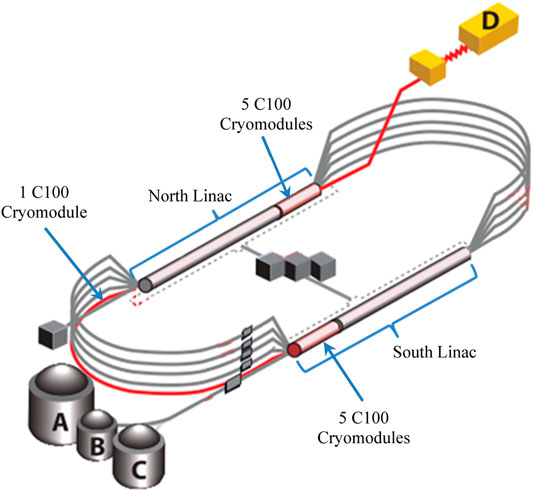
FIGURE 1. A schematic of CEBAF with the experimental halls (A, B, C, and D), indicating the locations of the C100 cryomodules used for this study.
At high energy, when cavity gradients are being pushed to their limits, CEBAF experiences frequent short machine downtime trips (events that can be resolved within 5 min) caused by numerous SRF system faults. Specifically, CEBAF operational runs in 2019 observed an average of 4.1 RF downtime trips per hour, culminating in approximately 1 h of beam time lost each day. The primary means of reducing the RF trip rate is to lower the accelerating gradient of problematic cavities, which in turn hinders CEBAF’s ability to reach 12 GeV.
Approximately 25% of these RF faults originated from the newly deployed C100 cryomodules. However, each C100 fault takes significantly longer to recover than their older counterparts. Determining which C100 cavity is associated with a fault and the underlying cause of the fault is not trivial. Typically, this work requires subject matter expertise, is time consuming, and is performed days or weeks after the events. In the interim, accelerator operators do their best to reduce trip rates through gradient reduction. However, incorrectly identifying the fault type makes it impossible to address the root cause, while incorrect cavity identification can lead to unnecessary reductions in cavity accelerating gradients.
In order to study the nature of these faults, we have implemented a new data acquisition system (DAQ), leveraging the digital LLRF system of the C100 cryomodules. The DAQ system is configured to capture 17 RF waveforms originating from each cavity in the 11 C100 cryomodules. The system is triggered at the onset of an RF failure, and a 1.64 s synchronized segment of the waveforms is retained for analysis (8,192 samples at 5 kHz). The system is configured such that 94% represents pre-fault data, while the remaining 6% is post-fault. This is illustrated in Figure 2.
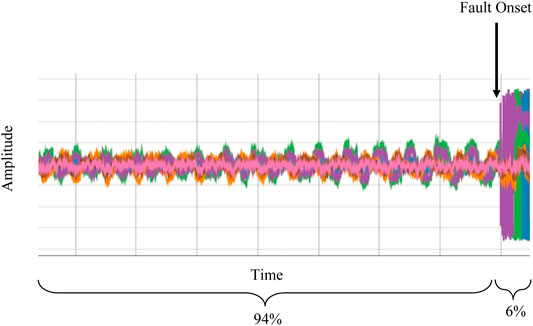
FIGURE 2. An example waveform segment captured by the DAQ system. The total duration of the captured waveform is 1.64 s.
Parameters such as sampling frequency and the ratio of pre-fault to post-fault data in the captured waveforms are established by subject matter experts (SMEs) such that the data contain sufficient information to determine the nature of an RF failure event (Tennant et al., 2020). Supplementary Appendix Table SA1 in Appendix A describes the 17 recorded RF signals. Typically, a subset of waveforms from each cavity in a cryomodule is inspected manually by SMEs to determine: 1) the identity of the cavity which faulted first, and 2) the type of fault. A typical operational run of CEBAF spans several weeks, and with the current RF downtime trip rate of 4.1/hr, our DAQ system collects data from several thousand events. The sheer number of waveforms and the subtlety of how certain faults manifest themselves make this manual inspection process laborious. Moreover, inspecting the data is usually conducted post-run due to the time-consuming nature of the process. Therefore, corrective measures can only be applied in the subsequent operational run. A fast RF cavity fault classification system (e.g. results reported seconds after a fault) enables CEBAF operators to apply corrective measures within the same operational run, thereby reducing unnecessary downtime.
A state-of-the-art ML based fault classifier model is currently deployed for use in CEBAF (Tennant et al., 2020). Many classical machine learning (ML) methods have been developed and utilized for time-series analysis in a variety of domains such as economics (Beveridge and Nelson, 1981; Caiado et al., 2006), the social sciences (Meidinger, 1980; Shumway et al., 2000), and healthcare (Chua et al., 2010; Shoeb and Guttag, 2010). While the present ML solution is adequate for our current “human-in-the-loop” paradigm, there is a desire to move toward an autonomous, fault prediction system where preventative action is taken before the fault occurs. Initial work suggests that the window of opportunity to predict an impending fault and effect a change to the system is a few hundred milliseconds (Vidyaratne et al., 2021). Therefore, to meet the stringent time constraints model inference times should be as fast as possible. Typical ML modeling for time-series analysis requires developing a pipeline of appropriate feature engineering, selection, and classification schemes (see Supplementary Appendix SAB). Consequently, such classical ML pipelines are inherently limited by the use of human expertise and intuition at each step of the learning process and by the need to explicitly compute features—which represents a potential bottleneck. To mitigate such limitations, this work investigates the performance of deep learning (DL) based methods.
Data of this paper provides details of the dataset and the preprocessing steps applied. Deep Learning Models discusses the deep recurrent learning (DRL) and convolutional neural network (CNN) architectures used in our study, while Results and Discussion describes the training methods and results for each, as well as a comparison to the performance of the ML model. Summary and Conclusion provides a summary of the work.
The dataset used in this study is curated using samples retrieved from CEBAF operational runs between the spring of 2019 and the fall of 2020. Each data sample consists of 17 time-series waveforms from each cavity of a given cryomodule. The data samples are inspected and annotated by an SME with labels corresponding to the identity of the cavity that faulted first and the type of fault. Note that the data collection for this project spanned several years over many CEBAF operational runs. The SME has routinely inspected the data, and over time has converged on 8 distinct RF fault types that can occur in the CEBAF system. The data used for this study is specifically selected from the latest operational runs.
The dataset utilized for training, validation and testing of the deep learning models consists of 6,027 events. The class-wise itemization of the dataset are shown in Figure 3. In addition to using all 17 waveforms per cavity, we also experiment using just 4 waveforms (GMES, GASK, CRFP, DETA2), identified by SMEs as having the greatest predictive power.
Note from Figure 3 that the fault class named “Multi cavity Turn Off” is directly correlated with the “All cavities” class in the cavity identification task. Nevertheless, we treat cavity identification and fault classification as separate tasks at this stage of the study in an effort to build independent and generalized models.
Time-series data is a sequence of values obtained through observations over time. The sequence of observations are usually evenly spaced temporally and commonly represented (Malhotra et al., 2015) as a vector,
The values within the raw signal waveforms feature large variations (orders of magnitude) between cavities and among signal types within individual cavities. Even the same waveform from the same cavity may be at different absolute values from fault to fault, as parameters like the gradient set point change between faults. However, fault behavior as exhibited by waveform is qualitatively similar relative to each other within a fault example. Accordingly, we apply time-series standardization using the z-score technique on each individual waveform from an individual fault example based on its own mean and standard deviation. No population-level standardization is applied. The z-score function applied to each time-series waveform
where
Deep learning models are essentially large-scale artificial neural networks that have the ability to learn complex tasks through examples. Hence, DL models effectively mitigate the limitations of ML pipelines by simultaneously learning the feature extraction, feature selection and classification steps through neural layers without human intervention.
This work investigates the efficacy of models based on two prominent DL architectures: deep recurrent learning and a convolutional neural network. Deep recurrent learning is based on long short-term memory (LSTM) layers which have the ability to learn both long-term and short-term temporal features. Additionally, the bi-directional functionality allows the LSTM to process time-series in the forward and backward directions simultaneously. This further enhances the ability of LSTM to retain patterns encountered at different locations of the time-series signal using both past and future contexts (Schuster and Paliwal, 1997). Convolutional neural networks, on the other hand, are adept at learning spatial dependencies in an image through the use of multiple trainable filters while maintaining efficiency with weight sharing. While CNNs have achieved state-of-the-art performance in many image processing and computer vision applications (LeCun et al., 1998; Krizhevsky et al., 2012; Simonyan and Zisserman, 2014), the data in this study consists of multiple RF signals that have high temporal, but little spatial, relevance. Therefore, it is necessary to apply a transformation to represent time-series data in a 2 dimensional image suitable for input to a CNN. A straightforward approach is to reconstruct waveforms directly in a one dimensional (Ullah et al., 2018; Eren et al., 2019) or multi-dimensional (Wei et al., 2018; Zhao et al., 2019; Cho and Hwang, 2020) array, which we refer to as direct signal conversion (DSC) and which is discussed more fully in Convolutional Neural Network.
A schematic of the DRL model architecture is shown in Figure 4. The first LSTM layer is configured to accept either 136 (17 signals per cavity × 8 cavities) or 32 (4 signals per cavity × 8 cavities) time-series signals. The model contains three bi-directional LSTM layers, each with 64 feature dimensionality at the front end for feature learning. The back end of the model is a branched architecture with multiple feed-forward neural layers to enable simultaneous learning of both cavity and fault identification tasks. That is, the features learned by LSTMs are shared among the two paths to perform both tasks in a computationally efficient end-to-end trainable manner. The deep LSTM classification model is fully implemented in Python utilizing the PyTorch deep learning library (Paszke, 2019).
End-to-end training for both tasks is achieved using two different cost functions simultaneously. Note that cavity and fault recognition tasks for this model are posed as a 9-class and 8-class classification problem, respectively (see Figure 3). Consequently, we use categorical cross-entropy (Géron, 2019) as our cost function for both tasks. The final cost to be optimized is a linear combination of individual costs as follows:
Note that we do not explicitly weight the individual costs as preliminary experiments found no gain in overall performance by doing so. We utilize the Adam optimization algorithm (Kingma and Ba, 2014) as the weight update scheme for the entire network, with a learning rate of 0.01 and a weight decay rate (for weight regularization) of 0.99. The network is trained for 50 epochs.
The time-series data we use for this study needs to be suitably represented in a multidimensional tensor format compatible for a typical CNN input. A straightforward representation of the signals as a 2-dimensional image is achieved simply by considering time as the second dimension. The total number of RF signals for each data sample (17 signals/cavity × 8 cavities = 136
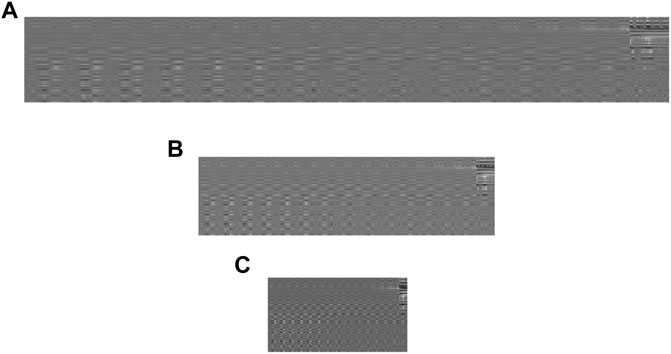
FIGURE 5. Example raw time-series direct conversion as 2D images for a Quench 100 ms fault type. (A) image representation of size 136 × 1,024, (B) image representation of size 136 × 512, (C) image representation of size 136 × 256.
The CNN is developed to process the input arrays and simultaneously classify the cavity and the fault type. This is achieved using a fully connected, branched architecture at the back end. The front end of the model consists of 5 convolutional layers, each followed by batch normalization, and dropout (rate = 0.5). Each layer is activated using the leaky ReLU function. The detailed architecture shown in Figure 6.
Note that the architecture in Figure 6 contains 2D filters of size 17 × 17 in the first layer. This filter size is deliberately set to ensure that the layer’s receptive field overlaps all 17 signals coming from each cavity at certain convolutional intervals, corresponding to the signal arrangement process of the direct conversion method. Consequently, the 2D filters enable the CNN to capture potential correlation patterns across signals within a cavity, and also across neighboring cavities.
Similar to the DRL, the CNN model architecture enables end-to-end training for both tasks using two different cost functions simultaneously. We utilize the same cost as defined in Eq. 2. Additionally, we utilize the Adam optimization algorithm as the weight update scheme for the entire network, with a learning rate of 0.001 and a weight decay rate (for weight regularization) of 0.99. The network is trained for 400 epochs.
We report quantitative performance figures for each DL system, and a performance comparison with the currently deployed ML pipeline (Tennant et al., 2020). Following the typical DL workflow, the training and testing of the DL models are carried out using a data split of 60% (3,616 events) for training, 20% (1,205 events) for validation, and 20% (1,206 events) for testing (stratified). Note that the same 1,206 testing events are used to evaluate all models to conduct a fair testing data performance comparison.
The training is performed for 50 epochs with batch-wise gradient updates. We obtain validation results at each epoch to verify proper training. Testing is only performed once the network is fully trained. We report training, validation, and testing accuracies for each experiment. Figure 7 shows loss and accuracy (number of correct classifications/total number of classifications) curves for DRL training and validation with input size: 32 signals × 256 time steps.
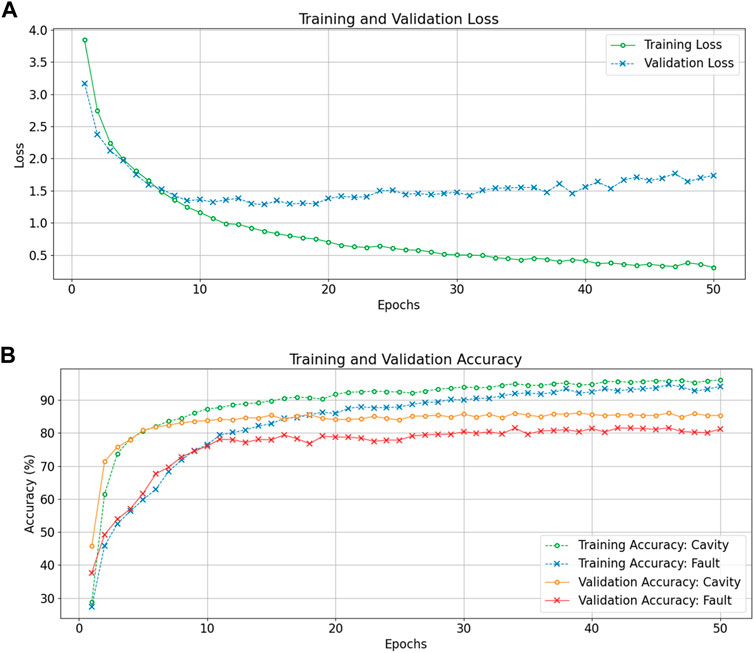
FIGURE 7. Training and validation loss curves (A), and training and validation accuracy curves (B) as a function of the epochs for the DRL classifier processing input data of 32 signal × 256 time steps.
The training and validation loss curves in Figure 7A (top plot) show that the DRL converges to a minimum quickly, albeit with signs of slight overfitting. However, the accuracy curves in Figure 7B (bottom plot) show the validation accuracies are quite stable for both tasks throughout the 50 epoch training duration. We also observe that the DRL quickly obtains high accuracy for the cavity classification task (roughly 80% after 5 epochs) while fault classification requires more training epochs to obtain a stable accuracy (80% is reached after 30 epochs). This indicates fault classification is a significantly more complex task than cavity identification.
We report and analyze the performance of the DRL model with three different input data combinations. In the first, denoted as DRL1, we utilize an input comprised of all 136 signals (17 signals from each cavity × 8 cavities) per sample with signals down sampled by a factor of 32 (input size: 136 × 256). In the second (DRL2), we use an input combination of 32 signals (4 signals from each cavity × 8 cavities) per sample with signals down sampled by the same factor of 32 (input size: 32 × 256). Thirdly (DRL3), we use an input with the same 32 signals but using a lower down sampling factor of 16 (input size: 32 × 512). Table 1 summarizes the classification results of both cavity and fault recognition tasks obtained using 3,616 training, 1,205 validation, and 1,206 testing events. Note that the testing dataset is commonly used to evaluate all models in this study.
The testing accuracy for each model configuration is reported with associated 95% confidence intervals (C.I.) accounting for the limited testing dataset size. These confidence intervals were calculated by treating the outcomes of individual classification models as independent and identically distributed (I.I.D.) Bernoulli random variables with probability p of making the correct prediction (De Veaux et al., 2005). We observe from Table 1 that DRL models show consistent testing performance for all three input combinations as evidenced by overlapping confidence intervals, albeit with subtle changes in the training and validation accuracies. Specifically, the large difference between training and validation scores for all three model configurations show signs of overfitting. Additionally, we observe that the down sampling factor of 16 in DRL3 shows a slight reduction in the point estimate for testing accuracy, possibly due to the recurrent layers having to essentially process double the amount of time steps compared to other inputs. However, note that the results of each configuration are still well within the error margins of each other and therefore requires further analysis with a larger testing set to form conclusions. Overall, DRL classification models exhibit better performance in cavity classification compared to fault classification.
We report and compare performance for different input sizes of the CNN and discuss the impact of input representation on the accuracy for cavity and fault recognition. CNN model analysis is conducted following the same data split method outlined in Deep Recurrent Learning. The training for CNN is performed for 400 epochs with batch-wise gradient updates. We obtain validation results at each epoch to verify proper training. Figure 8 shows training and validation loss/accuracy characteristics for the CNN with the direct conversion method (input size: 136 × 256).
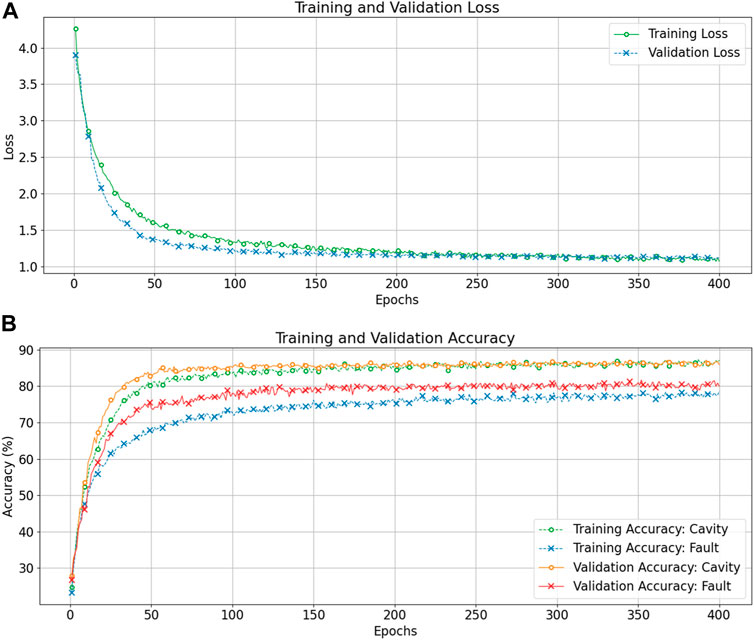
FIGURE 8. Training and validation loss curves (A), and training and validation accuracy curves (B) as a function of the epochs for the CNN with raw signal direct conversion input method with input size
The training and validation loss curves show consistent improvement over training epochs, though it requires a larger number of epochs compared to DRL models. The CNN model with DSC input exhibits slow but consistent convergence with no visible overfitting. The validation accuracy curves show a similar trend. Table 2 summarizes the results obtained through the CNN model with the DSC technique for input. Note that the computational efficiency of a CNN allows us to use larger input with all 136 signals easily (17 signals/cavity × 8 cavities). Therefore, we consider input combinations with down sampling factors 8, 16, and 32 to construct input images of size 136 × (1,024, 512, 256) denoted as CNN1, CNN2, and CNN3, respectively.

TABLE 2. Results of CNN model applying to raw data direct representation input. Performance after 400 epochs.
While the CNN with DSC inputs exhibits consistent performance across different down sampling factors, the largest input size of 136 × 1,024 seems to cause the model to overfit slightly. As before, these confidence intervals are generated by considering each outcome of a given model architecture as an I.I.D. Bernoulli random variable with probability p of making the correct prediction. This slight overfitting is evident by the larger difference between training and validation data accuracy compared to other, smaller input configurations. However, all three input combinations show consistent testing accuracies with highly overlapping confidence intervals.
We conduct a performance comparison between the two DL architectures in order to determine the feasibility for future deployment in CEBAF for online inference. The comparison is based on the model’s accuracy in identifying the C100 cavity that failed, identifying the type of RF fault, and the speed of inference for both tasks (i.e. the time taken for a raw example to be processed by a trained model). Statistically speaking, none of CNN models stands out as superior than the others. The same is true for the DRL models. Nevertheless, for the sake of comparison, we choose CNN2 and DRL2. Additionally, we compare the performance of these selected DL models with the current state-of-the-art ML models developed to perform the same tasks, in terms of classification accuracy as well as processing runtime.
We measure runtime performance across two operations, pre-processing (down sampling/feature extraction) and model inference (classification). As previously noted, the data standardization is common for all classification methods, and therefore excluded from runtime comparison. Pre-processing steps are performed on the CPU for all models. Inference occurs on the CPU for the ML model and GPU for the DL models. All calculations are performed on the same high-end mobile workstation (laptop), equipped with a hexa-core Intel Xeon E-2276M CPU and NVIDIA Quadro RTX 4000 GPU so that a reasonable baseline can be achieved for performance comparisons across CPU and GPU configurations of similar cost. More detailed timing studies are required to definitively pick the fastest model given a specific operating environment.
The ML pipeline implements a feature extraction scheme based on autoregressive analysis of each signal to obtain 192 features representing each event (Tennant et al., 2020). For the purpose of comparison, we implement this feature extraction scheme for each RF signal parallelized across a six-core CPU using six workers. The ML model uses two independent random forest classifiers (Breiman, 2001) (with CPU based parallelization using 6 workers) for cavity identification and fault classification tasks. (Appendix B provides a brief description of the ML pipeline). The signal down sampling routine for DL models is also optimized similarly for the given CPU. Table 3 summarizes the testing classification accuracies and runtime for each model.

TABLE 3. Performance comparison between best performing DRL, CNN, and ML models. The runtime for the ML pipeline is performed using CPU-based parallelization while the CNN and DRL models are performed on a GPU.
The classification accuracy comparison in Table 3 shows that while all three models perform cavity classification with similar accuracy, the ML pipeline achieves higher fault classification accuracy than the DL models. A more in-depth look into the classification outputs of each model can be obtained by inspecting the corresponding confusion matrices for cavity identification and fault classification as shown in Figure 9. The fault classification confusion matrices of DL models in Figures 9A,B show that significant misclassifications have occurred between “Controls Fault”, “Single Cavity Turn Off”, and “Multi-Cavity Turn Off” fault types. This indicates that further analysis into the characteristics of these fault types is required to understand the causes that inhibits DL performance. ML models perform comparatively well in the presence of limited data and noise, owing to the human engineered feature extraction and a choice of classification algorithms that are more robust against overfitting. Even though the fault identification confusion matrix of the ML model (Figure 9A) show that a certain confusion between “Controls Fault”, “Single Cavity Turn Off”, and “Multi-Cavity Turn Off” still exist, it is significantly less pronounced compared to DL models. Supplementary Appendix Tables SAC1, C2 in Appendix C further summarizes the DL and ML models fault class specific performance in terms of precision, recall rate, and F1-score.
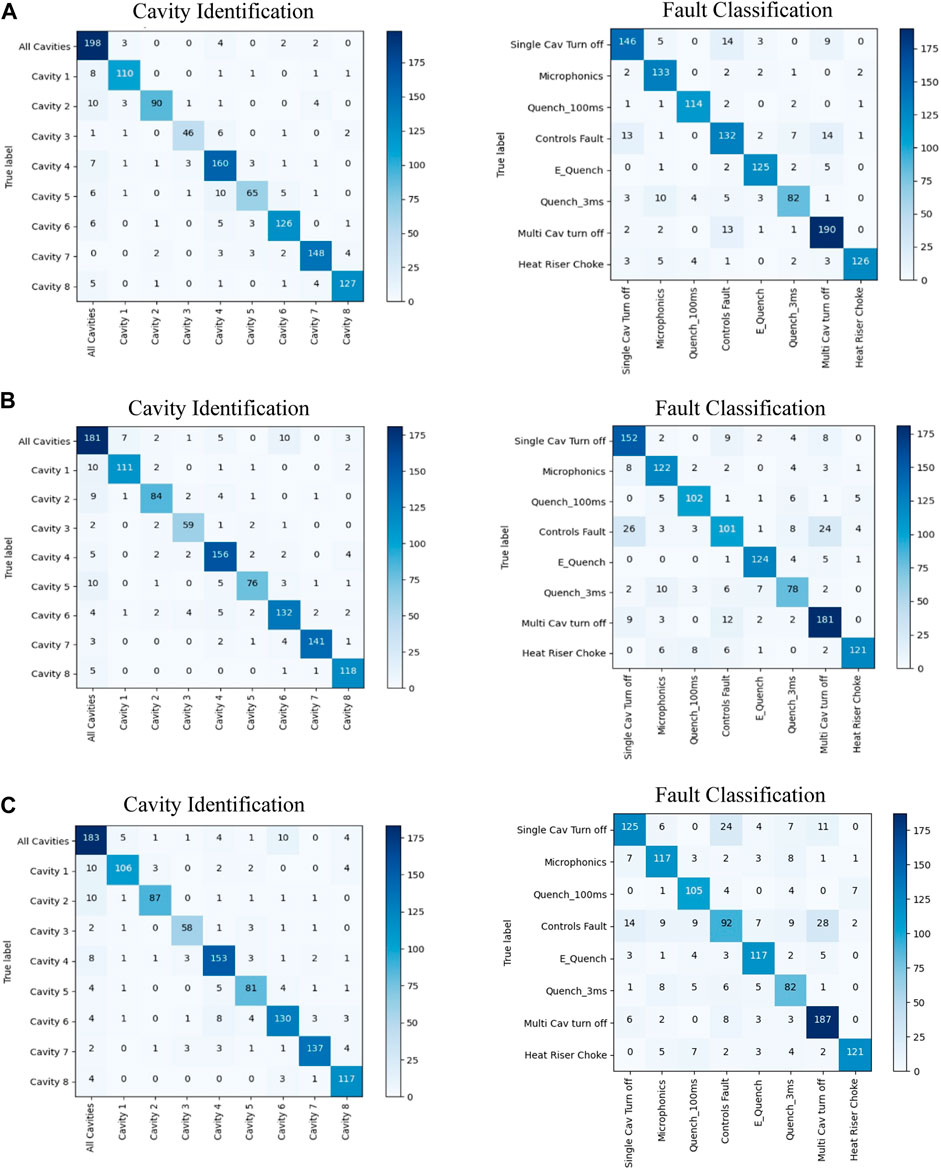
FIGURE 9. The cavity identification and fault classification confusion matrices for the (A) ML pipeline, (B) DRL model, and (C) CNN with direct conversion input model for testing data.
The DL models show an advantage over the ML pipeline in terms of runtime. While DL models process raw RF signals as input and produce cavity and fault classifications simultaneously, the ML pipeline is slowed by the autoregressive (AR) feature extraction step with a computational cost of 0.063 s per example. And in fact, the computation cost of the classification with the ML model is 0.047 s slower compared to the slowest inference with DL. These results are suggestive that the DL models would result in significantly faster runtimes, however the final operating environment would heavily influence relative runtimes.
This work investigates the ability of DL models to automate the process of cavity and fault classification using RF signals as an alternative to a conventional ML pipeline. We have developed custom DL models based on recurrent neural network and convolutional neural network architectures. The proposed DRL model draws from the ability to process RF time-series directly through its bi-directional LSTM layers to identify the faulty cavity and to classify the fault type simultaneously. The CNN-based architecture is typically used in computer vision applications. Consequently, this work utilizes a direct conversion method to provide a straightforward representation by arranging the raw RF signals from an example in a 2D array. This results in a lossless conversion yielding an input with a width and height corresponding to the length, and the number of RF signals, respectively.
Models that were developed on the DRL and CNN architectures and explored different data input sizes exhibit similar testing accuracies across both the cavity identification and fault classification tasks. In comparison to the ML pipeline—which is currently deployed and in use at CEBAF—the fault classification accuracy of the DL models suffer. We posit that this is due to the limitations in the number of examples, and representation of certain fault types in the current dataset, along with possible labeling noise. We continue to collect more data and will revisit this hypothesis in future studies. Nevertheless, the DL models achieve a sufficiently high accuracy so as to make them a beneficial tool, with the added benefit of having faster runtimes compared to ML. They, therefore, are a viable alternative to the conventional ML system for future autonomous tasks where runtime represents a key performance metric.
The data analyzed in this study is subject to the following licenses/restrictions: Raw data for the study were generated at Jefferson Lab. Derived data supporting the findings of this study maybe provided upon request. Requests to access these datasets should be directed to Chris Tennant: tennant@jlab.org.
CT, AS, LV, AC, and KI contributed to conception and design of the study. AC and TP organized the database. LV and CT performed the statistical analysis. LV wrote the first draft of the manuscript. CT and AC wrote sections of the manuscript. All authors contributed to manuscript revision, read, and approved the submitted version.
This work is supported by the U.S. Department of Energy, Office of Science, Office of Nuclear Physics under Contract No. DE-AC05-06OR23177.
The authors declare that the research was conducted in the absence of any commercial or financial relationships that could be construed as a potential conflict of interest.
All claims expressed in this article are solely those of the authors and do not necessarily represent those of their affiliated organizations, or those of the publisher, the editors and the reviewers. Any product that may be evaluated in this article, or claim that may be made by its manufacturer, is not guaranteed or endorsed by the publisher.
We wish to acknowledge the assistance provided by Dr. Norou Diawara of the department of mathematics and statistics of the Old Dominion University in conducting statistical confidence analysis for the classification models introduced in this study.
The Supplementary Material for this article can be found online at: https://www.frontiersin.org/articles/10.3389/frai.2021.718950/full#supplementary-material
Beveridge, S., and Nelson, C. R. (1981). A New Approach to Decomposition of Economic Time Series into Permanent and Transitory Components with Particular Attention to Measurement of the 'business Cycle'. J. Monetary Econ. 7 (2), 151–174. doi:10.1016/0304-3932(81)90040-4
Caiado, J., Crato, N., and Peña, D. (2006). A Periodogram-Based Metric for Time Series Classification. Comput. Stat. Data Anal. 50 (10), 2668–2684. doi:10.1016/j.csda.2005.04.012
Cho, J., and Hwang, H. (2020). Spatio-temporal Representation of an Electoencephalogram for Emotion Recognition Using a Three-Dimensional Convolutional Neural Network. Sensors 20, 3491. doi:10.3390/s20123491
Chua, K. C., Chandran, V., Acharya, U. R., and Lim, C. M. (2010). Application of Higher Order Statistics/spectra in Biomedical Signals-A Review. Med. Eng. Phys. 32 (7), 679–689. doi:10.1016/j.medengphy.2010.04.009
De Veaux, R. D., Velleman, P. F., Bock, D. E., Vukov, A. M., and Wong, A. C. (2005). Stats: Data and Models. Boston, MA: Pearson/Addison Wesley Boston.
Eren, L., Ince, T., and Kiranyaz, S. (2019). A Generic Intelligent Bearing Fault Diagnosis System Using Compact Adaptive 1D CNN Classifier. J. Sign Process. Syst. 91, 179–189. doi:10.1007/s11265-018-1378-3
Géron, A. (2019). Hands-on Machine Learning with Scikit-Learn, Keras, and TensorFlow: Concepts, Tools, and Techniques to Build Intelligent Systems. Sebastopol, CA: O'Reilly Media.
Kingma, D. P., and Ba, J. (2014). Adam: A Method for Stochastic Optimization. Ithaca, NY: arXiv preprint arXiv:1412.6980.
Krizhevsky, A., Sutskever, I., and Hinton, G. E. (2012). “Imagenet Classification with Deep Convolutional Neural Networks,” in Advances in Neural Information Processing Systems, 1097–1105.
LeCun, Y., Bottou, L., Bengio, Y., and Haffner, P. (1998). Gradient-based Learning Applied to Document Recognition. Proc. IEEE 86 (11), 2278–2324. doi:10.1109/5.726791
Malhotra, P., Vig, L., Shroff, G., and Agarwal, P. (2015). “Long Short Term Memory Networks for Anomaly Detection in Time Series,” in ESANN 2015 proceedings, European Symposium on Artificial Neural Networks, Computational Intelligence and Machine Learning. Bruges, Belgium. April 22–24, 2015. i6doc.com publ. (Presses universitaires de Louvain), 89.
Meidinger, E. E. (1980). Applied Time Series Analysis for the Social Sciences. New York City, NY: Sage Publications.
Paszke, A. (2019). “Pytorch: An Imperative Style, High-Performance Deep Learning Library,” in Advances in Neural Information Processing Systems, 8026–8037.
Reece, C. E. (2016). Continuous Wave Superconducting Radio Frequency Electron Linac for Nuclear Physics Research. Phys. Rev. Accel. Beams 19 (12), 124801. doi:10.1103/PhysRevAccelBeams.19.124801
Schuster, M., and Paliwal, K. K. (1997). Bidirectional Recurrent Neural Networks. IEEE Trans. Signal. Process. 45 (11), 2673–2681. doi:10.1109/78.650093
Shoeb, A. H., and Guttag, J. V. (2010). “Application of Machine Learning to Epileptic Seizure Detection,” in Proceedings of the 27th International Conference on Machine Learning (Haifa, Israel: ICML-10), 975–982.
Shumway, R. H., Stoffer, D. S., and Stoffer, D. S. (2000). Time Series Analysis and its Applications. Springer.
Simonyan, K., and Zisserman, A. (2014). in Very Deep Convolutional Networks for Large-Scale Image Recognition (Ithaca, NY: arXiv preprint arXiv:1409.1556).
Tennant, C., Carpenter, A., Powers, T., Shabalina Solopova, A., Vidyaratne, L., and Iftekharuddin, K. (2020). Superconducting Radio-Frequency Cavity Fault Classification Using Machine Learning at Jefferson Laboratory. Phys. Rev. Accel. Beams 23, 114601. doi:10.1103/physrevaccelbeams.23.114601
Ullah, I., Hussain, M., Qazi, E.-u. -H., and Aboalsamh, H. (2018). An Automated System for Epilepsy Detection Using EEG Brain Signals Based on Deep Learning Approach. Expert Syst. Appl. 107, 61–71. doi:10.1016/j.eswa.2018.04.021
Vidyaratne†, L., Carpenter, A., Suleiman, R., Tennant, C., Turner, D., Iftekharuddin, K., and Monibor Rahman, Md. “Initial Studies of Cavity Fault Prediction at Jefferson Laboratory,” in Presented at the 18th International Conference on Accelerator and Large Experimental Physics Control Systems (ICALEPCS 2021) (Shanghai, China. October 14-22, 2021, Paper presented.
Wei, X., Zhou, L., Chen, Z., Zhang, L., and Zhou, Y. (2018). Automatic Seizure Detection Using Three-Dimensional CNN Based on Multi-Channel EEG. BMC Med. Inform. Decis. Mak 18, 111–180. doi:10.1186/s12911-018-0693-8
Keywords: time-series classification, fault identification, superconducting radio-frequency cavities, particle accelerator, LINAC, deep recurrent learning, convolutional neural networks
Citation: Vidyaratne L, Carpenter A, Powers T, Tennant C, Iftekharuddin KM, Rahman MM and Shabalina AS (2022) Deep Learning Based Superconducting Radio-Frequency Cavity Fault Classification at Jefferson Laboratory. Front. Artif. Intell. 4:718950. doi: 10.3389/frai.2021.718950
Received: 01 June 2021; Accepted: 18 November 2021;
Published: 03 January 2022.
Edited by:
Domenico Giordano, European Organization for Nuclear Research (CERN), SwitzerlandReviewed by:
Elena Fol, European Organization for Nuclear Research (CERN), SwitzerlandCopyright © 2022 Vidyaratne, Carpenter, Powers, Tennant, Iftekharuddin, Rahman and Shabalina. This is an open-access article distributed under the terms of the Creative Commons Attribution License (CC BY). The use, distribution or reproduction in other forums is permitted, provided the original author(s) and the copyright owner(s) are credited and that the original publication in this journal is cited, in accordance with accepted academic practice. No use, distribution or reproduction is permitted which does not comply with these terms.
*Correspondence: Lasitha Vidyaratne, bGFzaXRoYXZAamxhYi5vcmc=
Disclaimer: All claims expressed in this article are solely those of the authors and do not necessarily represent those of their affiliated organizations, or those of the publisher, the editors and the reviewers. Any product that may be evaluated in this article or claim that may be made by its manufacturer is not guaranteed or endorsed by the publisher.
Research integrity at Frontiers

Learn more about the work of our research integrity team to safeguard the quality of each article we publish.